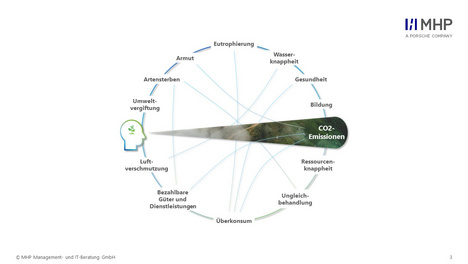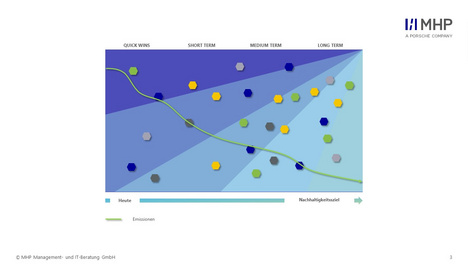
- Blog
- Published on: 13.12.2022
- 3:12 mins
Sustainability Roadmap
How to achieve a sustainable transformation with BAFA Funding
Our approach to developing a holistic sustainability roadmap
When we talk about sustainability today, the conversation most often turns to climate change and the 1.5-degree target, which all UN Member States committed to in 2015. This is understandable – after all, it is becoming clear just how devastating the consequences of further global warming will be. Nevertheless, it is important that key players in politics, society and economics do not lose sight of the fact that there is still much to do in other areas of sustainability besides decarbonization. The 17 Sustainable Development Goals (SDGs) of the United Nations are still the best blueprint we have for this.
We believe that there are many good reasons as to why companies should be aiming for transformation following the example of these 17 sustainability goals. And although many of those in charge are actually willing to make such a change, they often fail because they do not have a practical approach for implementation. Our approach to developing a holistic sustainability roadmap is designed to change this.
This kind of sustainability roadmap is created in three successive phases.
Ramp-up, status quo analysis, and then the actual process of sustainability roadmapping. Following completion of the third phase, the company will understand which sustainability goals are relevant and feasible for which business areas, which measures it must take to achieve these goals, and how the project can be operationalized over time.
Phase 1: Ramp-up
A transformation concept is developed, which can be used to derive a clear strategy with binding targets.
Phase 2: Status quo analysis
All existing sustainability initiatives and measures are recorded, evaluated and prioritized. Any shortcomings in relation to the targets must be remedied by developing further measures.
Phase 3: Roadmapping
The additional measures will be integrated into a roadmap. Target KPIs (such as costs, benefits, implementation time, complexity), can be used to evaluate progress and further measures to ensure that sustainability targets are met and can be developed continuously over time. The defined timeframe and the associated identification of short-, medium- and long-term goals ensure that partial successes are visible, while keeping sight of the big picture.
Transformation concept for GHG neutrality
How a transformation concept can be implemented, can be illustrated, for example, on the basis of the reduction of CO2 emissions. The start-up “right. based on science” has developed a science-based software tool that enables companies to analyze and evaluate their climate performance, among other things. This is made possible by the X-Degree Compatibility (XDC) model, which can analyze an entire company and indicate by how many degrees Celsius the climate would warm up by 2050 if the entire world were to behave in the same way as that company.
For example, the XDC model allows companies to determine their status quo (phase 2) and verify the success of their sustainability transformation. The model therefore gives companies a vision, but has no direct impact on the implementation of specific measures. The Federal Office for Economic Affairs and Export Control (Bundesamt für Wirtschaft und Ausfuhrkontrolle – BAFA) can help here, with a program that promotes the creation of a transformation concept designed to achieve GHG neutrality. The funding can add up to 80,000 euro, with a maximum funding rate of 50 per cent, or 60 per cent for SMEs.
Four prerequisites for BAFA funding
The funding can be used to certify the carbon footprint of one or more company locations within Germany, among other things. The funding can also be used for consultancy services that directly relate to climate protection management and transcend company boundaries to include the entire supply chain. BAFA will also support measurements or the collection and acquisition of data, if needed.
Four criteria must be met in order to fund a transformation concept:
- The current situation must be made transparent: Current GHG emissions must be recorded for a defined observation period (usually the previous financial year) or a GHG balance sheet must be prepared.
- A target situation needs to be formulated, with short- and medium-term measures that will enable GHG neutrality to be achieved by 2045 at the latest.
- At least one saving concept from the EEW program must be presented.
- The concept must be integrated into the company structure.
Have you already created your individual sustainability roadmap within your company?
The BAFA funding program is an excellent start-up aid for transformation into a sustainable enterprise. Ideally, the reduction of GHG emissions should be part of a holistic sustainability roadmap. We would be happy to help you create your roadmap!

